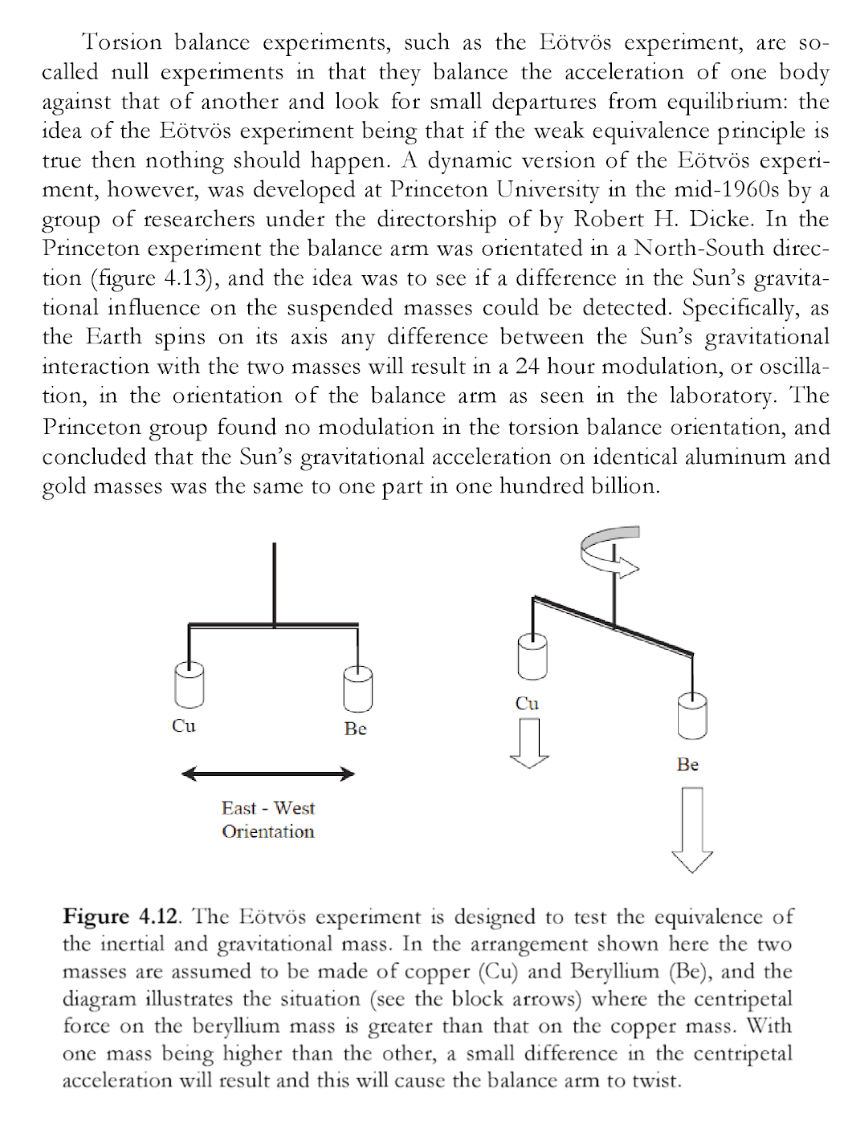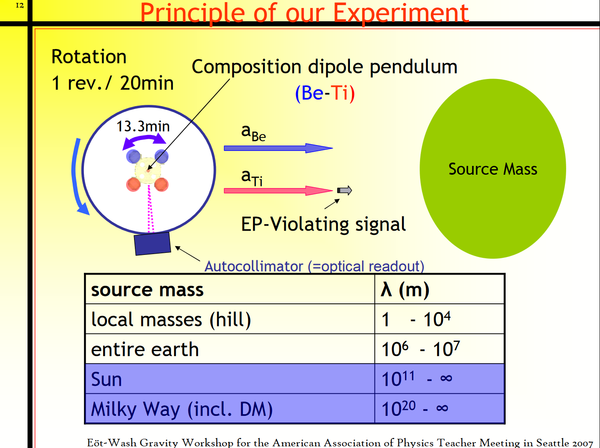Difference between revisions of "Variations in Gravity"
Tom Bishop (talk | contribs) |
Tom Bishop (talk | contribs) |
||
| Line 120: | Line 120: | ||
==Mainstream Answer: Selective Gravity== | ==Mainstream Answer: Selective Gravity== | ||
| − | The paradox that external celestial gravity and other effects cannot be felt by the test bodies in the torsion balance experiments of Dicke, Eötvös, and others, is addressed by mainstream science with a concept of selective gravity. In the book [https://en.wikipedia.org/wiki/Gravitation_(book) ''Gravitation''] by Charles W. Misner, Kip S. Thorne, and John Archibald Wheeler, on the topic of the Dicke-Eötvös experiments we read [http://web.archive.org/web/20190409223124/https://imgur.com/a/NHH9pBZ the following at the bottom of p.1055]: | + | The paradox that external celestial gravity and other effects cannot be felt by the test bodies in the torsion balance experiments of Dicke, Eötvös, and others, is addressed by mainstream science with a concept of selective gravity. In the book [https://en.wikipedia.org/wiki/Gravitation_(book) ''Gravitation''] by Charles W. Misner, Kip S. Thorne, and John Archibald Wheeler, on the topic of the Dicke-Eötvös experiments, we read [http://web.archive.org/web/20190409223124/https://imgur.com/a/NHH9pBZ the following at the bottom of p.1055]: |
{{cite|The uniqueness of free fall, as tested by the Dicke-Eötvös experiments, implies that '''spacetime is filled with a family of preferred curves'''', the test-body trajectories.}} | {{cite|The uniqueness of free fall, as tested by the Dicke-Eötvös experiments, implies that '''spacetime is filled with a family of preferred curves'''', the test-body trajectories.}} | ||
Revision as of 22:59, 9 April 2019
The Variations in Gravity are the supposed variations to gravity due to either the gravity gradient of the earth or due to the presence of masses such as hills or celestial bodies. A number of tests have been conducted in search of these variations.
It has been found that in experiments on medium, long, and 'celestial' ranges, "gravity" does not deviate from the Universality of Free Fall or the Equivalence Principle. Nor can external gravity sources be felt. Gravity appears to behave as if the earth is accelerating upwards, that there is no gravity gradient, and there are no other gravitating sources around us.
Celestial Variations in G
The Equivalence Principle Torsion Balance tests are incredibly reliable precision machines which are used to measure the Equivalence Principal to increasing sensitivity. Experimenters have redesigned the Equivalence Principle's Torsion Balance tests to try and detect the gravity variations caused by the sun, moon, and the tidal forces. It was found that the gravitational influence of the sun, moon, or the tidal forces could not be measured as manifest of the attraction of the bodies in the experiments. Variations to "gravity" did not appear.
Princeton Experiment
From 'The Pendulum Paradigm: Variations on a Theme and the Measure of Heaven and Earth', by Professor Martin Beech, we read the following on p.176:
Essentially, the experiment is summarized as follows:
“ In the Princeton experiment the balance arm was oriented in a North-South direction (figure 4.13), and the idea was to see if a difference in the Sun's gravitational influence on the suspended masses could be detected. Specifically, as the Earth spins on its axis and difference between the Sun's gravitational interaction with the two masses will result in a 24 hour modulation or oscillation, in the orientation of the balance arm as seen in the laboratory. The Princeton group found no modulation of the torsion balance, and concluded that the Sun's gravitational acceleration on identical aluminum and gold masses was the same to one part in one hundred billion. ”
The masses were not attracted to the sun in the experiment, to an accuracy of one part in one hundred billion.
Moscow State University Experiment
The experiment was repeated and improved by researchers at Moscow State University. The title of the paper states the conclusion:
Verification of the Equivalence of Inertial and Gravitational Mass
V. B. Branginsky and V. I. Panov
Full Text Link (Archive)
“ During the period 1959-1964 the principle of equivalence was again tested by Dicke, Krotkov, and Roll. [2] A hypothetical difference between the accelerations of two bodies, made of gold and aluminum, respectively, in the gravitational field of the sun was measured. From measurements conducted during many months it was concluded that the ratio of the inertial and gravitational masses for these two bodies does not differ by more than 3 x 10-11 with 95% confidence.[2] An analysis of the experimental work in [2] shows that it is possible, in principle, to considerably improve the resolution by using a mechanical oscillatory system having a long relaxation time.[3] We shall here describe an experiment intended as a new test of the principle of equivalence.
1. MEASUREMENT TECHNIQUE
We retained the experimental scheme of Dicke, Krotkov, and Roll. [2] A torsion balance falling together with the earth in the gravitational field of the sun should be acted upon by a torsional mechanical moment that is proportional to a hypothetical difference between the accelerations of the materials comprising the balance (if the principle of equivalence is not fulfilled). Because of the earth's rotation this moment should vary sinusoidally with a 24-hour period (Fig. 1). ”
Repetitions
Additional experiments of this class are described (Archive). The two experiments experiment in this list is the Princeton and Moscow State experiments above:
| Authors | Year | Description | Accuracy |
|---|---|---|---|
| Roll, Krotkov and Dicke | 1964 | Torsion balance experiment, dropping aluminum and gold test masses | difference is less than one part in one hundred billion |
| Branginsky and Panov | 1971 | Torsion balance, aluminum and platinum test masses, measuring acceleration towards the sun | difference is less than 1 part in a trillion (most accurate to date) |
| Eöt-Wash | 1987– | Torsion balance, measuring acceleration of different masses towards the earth, sun and galactic center, using several different kinds of masses | difference is less than a few parts in a trillion |
The Eöt-Wash experiments were repeated by others:
https://plato.stanford.edu/entries/physics-experiment/app4.html (Archive)
“ The torsion-balance experiments of Eöt-Wash were repeated by others including (Cowsik et al. 1988; Fitch, Isaila and Palmer 1988; Adelberger 1989; Bennett 1989; Newman, Graham and Nelson 1989; Stubbs et al. 1989; Cowsik et al. 1990; Nelson, Graham and Newman 1990). These repetitions, in different locations and using different substances, gave consistently negative results. ”
Long Range Variations in G
Universality of Free Fall
The Newtonian gravitational constant: recent measurements and related studies
By George T Gillies
https://iopscience.iop.org/article/10.1088/0034-4885/60/2/001/pdf
p.200
5. Searches for variations in G
5.1. Spatial dependence of G
“ Searches for a change in G with intermass spacing have constituted a compelling quest in laboratory gravitation, especially during the past 25 years. The motivations for carrying out this kind of study were originally empirical, with the results of various benchtop experiments being interpreted in terms of either a value for or limit on some distance-dependent form of the gravitational constant (i.e. a G(r) effect), or in terms of a breakdown in the inverse square law (i.e. a modification to it of the form 1/r2+δ, where δ is the departure parameter). Then, in the 1980s, observations that seemingly revealed evidence for non-Newtonian gravity at larger distance scales (Stacey et al 1987) fuelled much additional interest in this line of work. The contemporaneous suggestion by Fischbach et al (1986) that there may be previously undiscovered, weak, long-range forces in nature provided further impetus for investigating the composition- and distance-dependence of gravity, since the presence of any such effect might reveal the existence of a new force. During this time, a theoretical framework for admitting non-Newtonian effects into discussions of the experimental results was emerging. It led to the practice of using the laboratory data to set limits on the size of the strength-range parameters in a Yukawa term added onto the Newtonian potential, and this has become a standard method for intercomparing the results of this class of experiments. Even though convincing evidence in favour of such new weak forces was never found, the many resulting experiments, when viewed as tests of the universality of free-fall, did much to improve the experimental underpinnings of the weak equivalence principle (WEP) of general relativity. In fact, searches for departures from the inverse square behaviour of Newtonian gravity have now come to be interpreted as attempts to uncover violations of the WEP. ”
p.202
“ Other recent experimental searches for a breakdown in Newtonian gravity at large distances include a second set of tower gravity measurements made by Romaides et al (1994). Their data, taken at five points over a nearly 500m vertical rise, reconfirmed the exactness of the inverse square law. A similar result over a vertical distance of approximately 320 m was obtained at a meteorological tower in China by Liu et al (1992). ”
It should be noted that 500 meters is 1640.42 feet, and about as high as the Shanghai World Financial Center, a skyscraper in China.
Medium Range Variations in G
Eöt-Wash Hill Experiments
From No Easy Answers: Science and the Pursuit of Knowledge by Allan Franklin, on p.70 we read a summary of the Eöt-Wash hillside experiments with the rotating torsion balance:
“ The Eöt-Wash experiment used a torsion pendulum located on the side of a hill on the University of Washington campus. If the hill attracted the copper and beryllium test bodies that were used in the apparatus differently, then the torsion balance would experience a net torque. None was observed. ”
An Eöt-Wash presentation explains (Archive) that the influence of an external source mass on these type of experiments would be a violation of the Equivalence Principle (EP).
One will notice from the graphic above that any horizontal pulling phenomenon would violate Equivalence Principle which states that gravity operates exactly like a rocket ship accelerating upwards at 1G with no other gravitating bodies around.
Short Range Variations in G
On shorter ranges, such as with the Cavendish Experiment, it has been seen that the attraction is not consistent, which might suggest that there are other effects at that range creating or modifying those results. See the Cavendish Experiment.
History of the Torsion Balance
The history of the Torsion Balance experiments began in 1889, with Barron Rosland von Eötvös' attempt to detect the Coriolis force.
Foundations of Modern Cosmology
By Professor John F. Hawley, and Katherine A. Holcomb
From p.219 of the above text we read:
“ The first highly accurate experiment to test the equivalence principle was performed in 1889 by Barron Rosland von Eötvös. Eötvös constructed a device called a torsion balance. He suspended two bodies of nearly equal mass but different composition, from a beam which hung from a very fine wire precisely at its center. If the magnitudes of the Coriolis force (from the Earth's rotation) and the gravitational force had differed between the bodies due to their differing composition, Eötvös would have been able to detect a twisting of the wire. None was seen, and Eötvös was able to conclude that inertial and gravitational mass was equal, to approximately one part in 10^9. In the 20th century, Robert Dicke and others pushed the limit of such an experiment to 10^11, but the Baron's results were sufficient to convince many, including Einstein, that inertial mass and gravitational mass are equivalent. ”
Mainstream Answer: Selective Gravity
The paradox that external celestial gravity and other effects cannot be felt by the test bodies in the torsion balance experiments of Dicke, Eötvös, and others, is addressed by mainstream science with a concept of selective gravity. In the book Gravitation by Charles W. Misner, Kip S. Thorne, and John Archibald Wheeler, on the topic of the Dicke-Eötvös experiments, we read the following at the bottom of p.1055:
“ The uniqueness of free fall, as tested by the Dicke-Eötvös experiments, implies that spacetime is filled with a family of preferred curves', the test-body trajectories. ”
The reader may decide whether this answer, invented for the purpose, is valid or sufficient.


